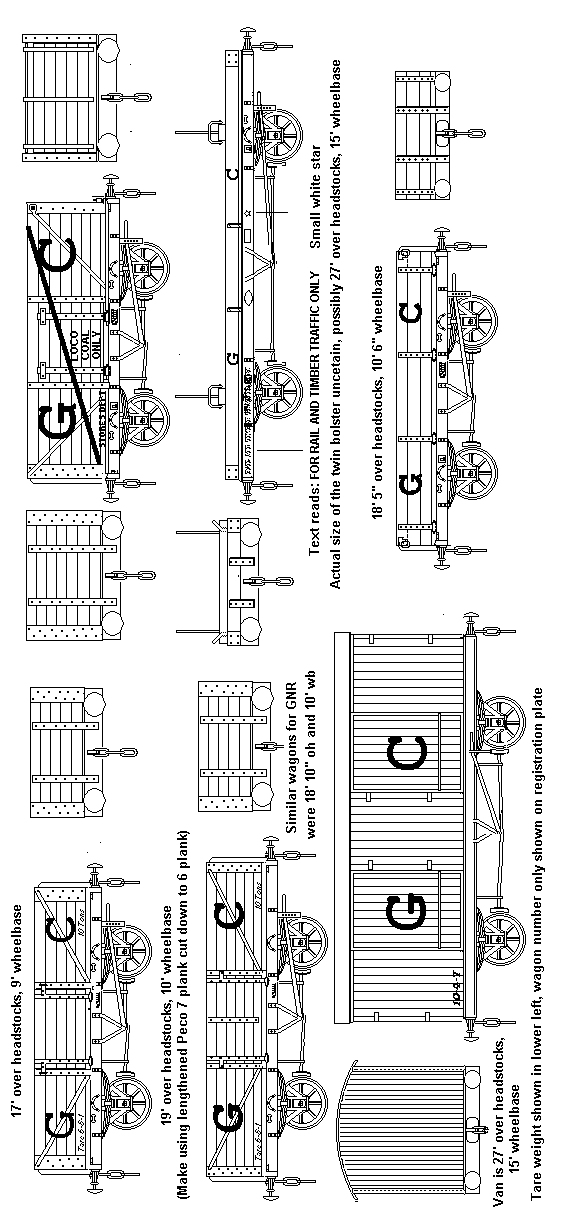
Great Central Railway
(Note: Numbers in brackets refer to specific references)
The Great Central Railway was a new name for an existing system originally based on the
Sheffield-under-Lyne & Manchester Railway, built to link Sheffield and Manchester via the well known Woodhead Tunnel. In 1847 the SAMR expanded by amalgamation with three other railways and the Grimsby Docks Company to form the Manchester Sheffield & Lincolnshire Railway: Grimsby flourished as a fishing port (it was the largest such port in the world) and the company purchased the South Yorkshire Railway in the 1860's, giving it a considerable volume of coal traffic. The name changed to Great Central in the 1890's as the company built its last great London Extension to its new terminus at Marylebone. This latter was the last major route built in Britain and probably never paid for itself. The GCR handled the largest single flow of freight into London and as with most lines most money came from the freight operations. In the case of the GCR the disparity was marked with less than a quarter of its revenue coming from passengers and over a third from freight trains.
Around the turn of the century there was considerable interest in high capacity bogie vehicles which had proved successful in America. Several British companies experimented with vehicles of this type and the GC built some very large bogie wagons to carry locomotive coal.
The success of the Grimsby fish trade necessitated a large stock of fish vans of various designs, both four wheel and bogie. These vans would have been a regular sight on the main lines feeding the towns and cities, unfortunately the nature of the cargo meant that these vans featured difficult to model slatted and louvred sides. As far as I am aware the only open vehicles used for fish traffic were specialised wagons built to carry tanks of live fish.
The company subsequently built a completely new deep water port at Immingham, providing itself with additional general merchandise traffic.
Goods livery was a lead grey body, about the same as the grey used by the LMS, with black underframe and white lettering, initials in the form G C, usually in a serif font. Refrigerator vans were a lighter shade of grey with lettering in white shaded black and the word REFRIGERATOR in red. Passenger livery was originally chocolate brown with 'French grey' upper panels. Sometime after 1900 this changed to dark brown (darker I think than the GWR brown but I could be wrong on that) with pale cream upper panels. Non passenger coaching stock was all over brown, slightly lighter than GWR coach brown, with white lettering (at least on the fish vans). After 1910 some passenger coaches appeared in varnished teak as seen on the Graham Farish LNER coaches.
Fig ___ GCR

The long wheelbase double-bolster had a fifteen foot wheelbase and represents a relatively simple modification to the Peco twin bolster kit, just cut away the sides and replace with plain card. If you wish to model the brake gear I suggest you use a brake van chassis and cut away the foot boards, this saves you having to remove the brake detail and the outer parts of the swinging link suspension. New brake gear can then be added from fine brass wire (or do what I did and use the trimmed off swinging link parts for the V hangers and add handles from 10x20 thou strip).
The six plank wagon is a Peco wagon seven plank kit with the top plank removed, the five planker is a shortened Peco five plank wagon with detail changes added using plastic strip.
The long wheelbase vans were built using Peco pallet van kits, the double door version is the correct length whereas the shorter type with two sliding doors per side is mounted on an unaltered Peco chassis.
References:
(1) The Great Central Railway Volume 3 by George Dow published by Locomotive Publishing Co in 1959 ISBN xxxxxxx. The third and final volume in a series describing the history of the line in great detail, this volume has a number of useful drawings of both goods and passenger stock as well as several photographs.
(2) Great Central Album by George Dow published (reprinted?) by Ian Allen in 1978 Includes several black and white photographs of GCR goods stock.
(3) A Pictorial Record of LNER Wagons by Peter Tatlow - OPC - 1976 - ISBN 0 92888 92 7 Contains a few photographs of ex GCR wagons.
Societies:
Available Models
Bill Bedford Models, Leebiton, Sandwick, Shetland, ZE2 9HP
Mr. Bedford offers etched kits of GCR/LNER: D.13 ten ton van with cupboard doors, D14 van with sliding doors, the D.16 outside framed van, a ten ton fish van and a six wheeled brake van.
Graham Hughes Kits 20, MacKelvie Road, Lamlash, Isle of Arran Strathclyde KA27 8NP
Graham Hughes offers a white metal kit of the GCR six wheeled brake van and the eleven foot wheelbase ten ton cattle wagon